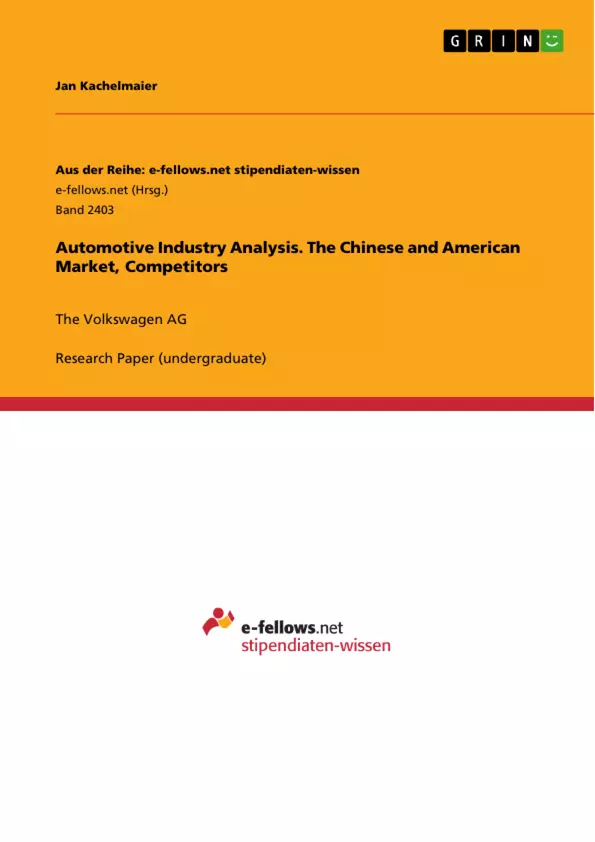The paper analysis the automotive industry in general as well as the relative position of the Volkswagen AG. Furthermore, VW's competitors are assessed and recommendations for actions are formulated.
In the beginning the creation of the automobile seemed less of a need and more of a luxury, as the cars could only be afforded by the well off. The very first steam car took to the road in France in 1768 – but Cugnot's novel idea did not trigger the beginning of the car industry. After Henry Ford’s model made its debut, owning a car was a symbol of status, because it could only be afforded by the wealthy. Once the process of Henry Ford’s mass production was introduced, cars could be afforded by a wider dynamic of people, and ownership became an affordable growing trend. The production of automobiles was a great help to the economy. It provided jobs across industries including positions in steel and machine tool makers for the different metal parts of the car. The increase in the need of supplies and other parts of the car including the battery, head lights, paint, and interior upholstery, were the driving forces for new businesses to thrive. Cars being a part of the everyday norm meant they would need routine car maintenance which became a major source of business. This also led to the increase of petroleum sales as the demanded use of cars increased. When WWII came the US was able to use the jeep for military use, additionally Chrysler reworked the jeep design to create tanks. Moreover, car production in Europe turned its focus from “the people’s car” to cars designed for the military.
Table of Contents
- Industry
- An Introduction to the Automobile industry
- Industry Development
- Dynamics
- Automobile Industry Strategies
- Threat of alternative means of transportation
- Rivalry Between Leading Automobile Manufacturers
- Analysis of the Volkswagen Group
- Introduction
- Analysis and evaluation of the Volkswagen Group's performance
- Examination and Evaluation of the Volkswagen Group's Strategy
- VW Management
- SWOT Analysis of the VW Group on the Chinese Market
- SWOT Analysis of the VW Group on the American Market
- Key success factors of VW
- Competitors
- Analysis of the Competitors
- The Governance Corporate
- Supply Chain Management
- Leadership and Culture
- Profit
- Recommendation
- Recommendation for the VW Group
Objectives and Key Themes
This project aims to conduct a comprehensive analysis of the Volkswagen Group, examining its performance, strategy, and key success factors within the global automotive industry. The study also delves into the competitive landscape, analyzing key competitors and their respective strengths and weaknesses.
- The evolution of the automotive industry and its key trends.
- The strategic positioning and performance of the Volkswagen Group.
- The competitive dynamics within the automotive industry.
- The impact of alternative transportation options on the industry.
- The importance of sustainability and environmental considerations in the automotive sector.
Chapter Summaries
The first chapter provides an overview of the automotive industry, tracing its historical development and outlining key dynamics shaping its current landscape. Chapter two focuses on the Volkswagen Group, examining its performance, strategy, and management structure. The third chapter dives into the competitive landscape, analyzing key competitors and their respective strengths and weaknesses. The final chapter offers recommendations for the Volkswagen Group based on the insights gained from the preceding analysis.
Keywords
This work focuses on the automotive industry, Volkswagen Group, competitive analysis, industry dynamics, strategic positioning, key success factors, alternative transportation options, sustainability, and environmental considerations. The analysis utilizes frameworks such as SWOT analysis to assess the strengths, weaknesses, opportunities, and threats faced by the Volkswagen Group.
- Quote paper
- Jan Kachelmaier (Author), 2016, Automotive Industry Analysis. The Chinese and American Market, Competitors, Munich, GRIN Verlag, https://www.grin.com/document/369750




